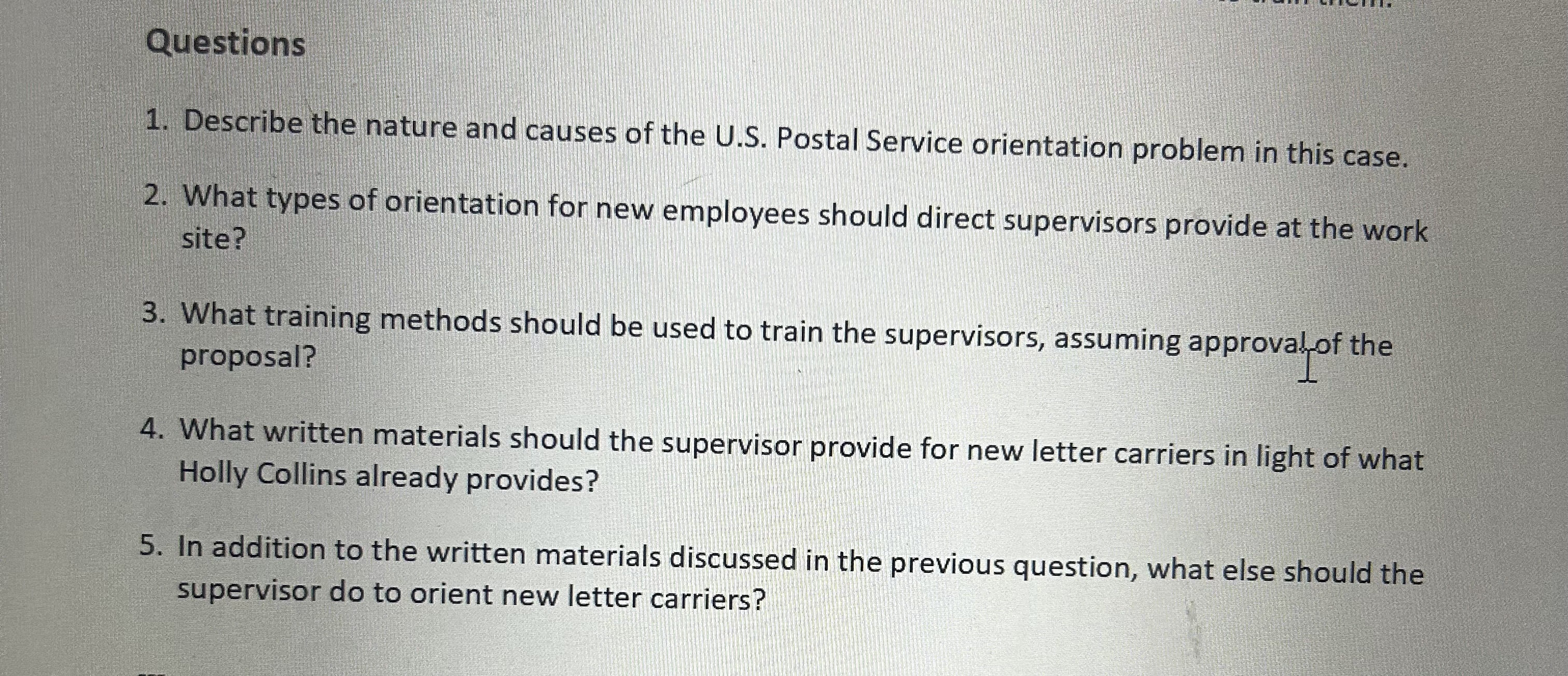Answered step by step
Verified Expert Solution
Question
1 Approved Answer
Case Study: The Orientation Problem. Holly Collins is a letter carrier & a part time trainer of letter carriers for the US postal Service in
Case Study: The Orientation Problem.
Holly Collins is a letter carrier & a part time trainer of letter carriers for the US postal Service in a major city in western Pennsylvania. She trains all new letter carriers in her service area, which encompasses the western half of her state. Over the past five years she has trained new letter carriers. Typically, the training is offered prior to the new letter carrier's entry onto the job, although sometimes it occurs shortly thereafter. The training program typically encompasses the orientation of new employees to the US Postal Service & the development of specific skills needed by the new letter carrier. The latter involves practice in casing mail ie sorting to appropriate locations of a case in preparation for delivery, reading maps, determining appropriate sequencing of delivery, & customer relations. The total training program takes full days day of orientation & days of skills trainingThe orientation part of the training program encompasses an orientation packet & a discussion of various Postal Service policies & procedures. The orientation packet typically includes info about employee benefits, holidays, copies of certain standard forms ie IRS withholding forms outline of emergency & accident procedures, key terms used in the US Postal Service, copies of the health & life insurance options, & telephone numbers & locations of the personnel department & other important offices. In addition, an explanation of the US Postal Service operation & purpose is provided. This explanation includes the training to be received, the letter carrier's duties and responsibilities, job standards and expected production levels, Postal Service rules & regulations, & the chain of command for reporting purposes are also provided. Collins concludes her orientation with an offer of help & encouragement for the future. The assumption built into the orientation is that it will be supplemented at the job site by the direct supervisor who will provide all the necessary information about the particular facility, the personnel at the facility, the area covered by the route or routes to which the new employee will be assigned, & the additional written info such as the employee handbook & the union contract. According to Postal Service policy, each new letter carrier should get days of on the job training, of which is paid for by the training division & are charged to the supervisor's production. Collins learned from subsequent conversations with her former trainees over the past years that the orientation provided by the direct supervisor varied from practically nothing to fairly extensive. In some stations, the supervisor greeted the new employee, introduced the person to other employee, & explained their own expectations regarding attendance, personal conduct, & productivity. Then, the employee was given an assignment & allowed to "sink or swim." Several supervisors were known in the Postal Service to be "SOBs." While percent of new hires have survived their probationary day period over the past years, less than percent survived in certain stations. Last night Collins received a telephone call from Sarah Jones, of her former trainees who finished training weeks ago. Jones is a single parent with school age children who had left her job as a secretary & taken the letter carrier job in order to make more money. Jones was in tears as she described her experience at her station. Her supervisor had given her no written materials, introduced her to only one other employee, & has shifted her from route to route over the weeks she has worked at the facility. No help or support of any kind has been offered, but the supervisor has continually berated her for the number of hours she has taken to case & deliver routes. She had tried to study maps during her days off in order to learn the various areas covered by various routes, but this only helped a little. Each route had to be delivered in a particular order & it took time to learn the sequence. The other letter carriers were all stressed & working overtime themselves. Consequently, they ignored her and offered no assistance. Jones told Collins that she was on the verge of quitting. Collins told her to "hang in there because it does get easier with time." As a result of all the complaints she had received from former trainees some who survived the day probation period Collins decided to recommend to the area postmaster a program to train supervisors as to how to orient new letter carriers. However, she was not sure what specific items the supervisors should include in their new employee orientation & how to train them.

Step by Step Solution
There are 3 Steps involved in it
Step: 1

Get Instant Access to Expert-Tailored Solutions
See step-by-step solutions with expert insights and AI powered tools for academic success
Step: 2

Step: 3

Ace Your Homework with AI
Get the answers you need in no time with our AI-driven, step-by-step assistance
Get Started


